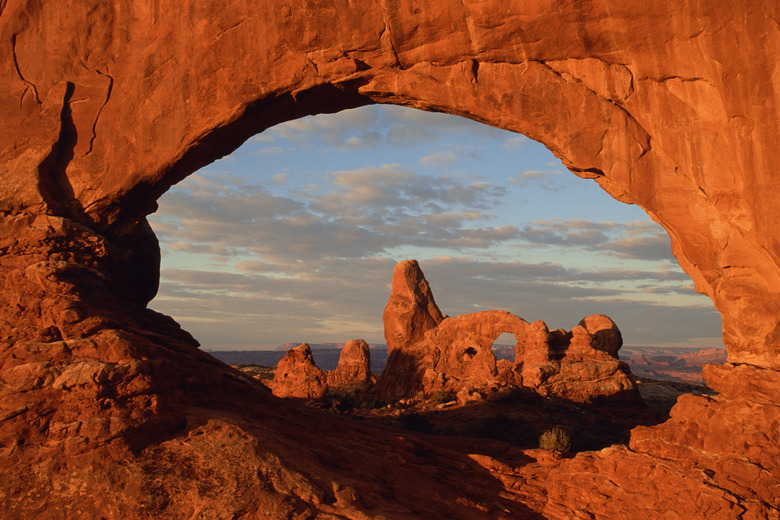What Causes Weathering Of An Arch?
Globally quite rare, natural rock arches evoke a sense of intrigue and awe whenever humans encounter them. These bows of stone above empty space — often naked, sometimes draped in vegetation — demonstrate the earthly powers of weathering and erosion. Arches, which by the broadest definition also include rock bridges, have developed in a variety of settings and situations — from the Sahara Desert to the outback of the American Southwest — but many share basic geologic backstories.
Weathering and Arches
Weathering and Arches
Along with mass wasting and erosion, weathering is one of three major geological processes of denudation, by which rock is broken down and transported. Weathering technically involves mechanical, chemical and biological forces that dismantle rock, but these forces don't extensively remove the resulting fragments — a "cleanup" is accomplished by gravity, as in mass wasting, or water and wind, as in erosion. Weathering is a primary tool by which arches are sculpted, often through exfoliation — where whole plates and curls of rock slough off, eventually forming "windows" and ultimately, perhaps, huge holes — and water is the major agent.
Wedging
Wedging
A pre-eminent force creating arches in both arid and nonarid settings is frost-wedging, a kind of mechanical weathering. Water trickles into natural rock joints and freezes into ice, widening the fracture. After the ice melts, the liquid water penetrates deeper into the rock mass to freeze and pry. Over millennia, such frost-wedging can gut a rock face to form an arch. A related process, salt-wedging, is notable in deserts: Water evaporated out of rock crevices leaves behind salt crystals that, like ice, can exert force that becomes inexorable and dismantling over time
Erosion and Arches
Erosion and Arches
Water also acts as an erosive force to create arches. Erosion is a denudation process distinct from weathering; in addition to actively breaking rock itself, erosion also transports the fruits of weathering — boulders and cobble — away from their source. An erosive stream can bore out a recess beneath overhanging rock; if the stream continues to flow beneath its handiwork, the rock span is called a natural bridge, a specific form of natural arch. Along coastline, surging ocean waves can erode arches out of sea cliffs — as along the Orkney coast of Scotland or the U.S. West Coast.
Other Processes
Other Processes
Other geological actions can set the stage for arch-forming weathering. In Arches National Park in southeastern Utah, for example, which contains the world's greatest collection of the landforms, faulting of overlying sandstone due to the instability of underlying salt beds produced rock jointing and exposures that made strata more vulnerable to weathering. Chemical weathering often works alongside mechanical weathering to create arches — as where acidified rainwater dissolves carbonate rock. Geologists in the past have erroneously pinpointed wind as a major arch-forming agent of erosion, but subsequent research suggests this is not the case. Wind likely does not form rock arches but can polish and maybe expand existing ones via the abrasion of windblown grit, as well as remove miniscule weathered debris.
References
- Natural Arch and Bridge Society: Frequently Asked Questions
- Physical Geography: A Landscape Appreciation; Tom L. McKnight
- Geology of the National Parks; Ann G. Harris, Esther Tuttle
- National Park Service: Geology Resources Division – Arches National Park, Utah: Park Geology
- Natural Arch and Bridge Society: Natural Arch Formation
- National Park Service: Arches National Park – Geologic Formations
Cite This Article
MLA
Shaw, Ethan. "What Causes Weathering Of An Arch?" sciencing.com, https://www.sciencing.com/causes-weathering-arch-20190/. 24 April 2017.
APA
Shaw, Ethan. (2017, April 24). What Causes Weathering Of An Arch?. sciencing.com. Retrieved from https://www.sciencing.com/causes-weathering-arch-20190/
Chicago
Shaw, Ethan. What Causes Weathering Of An Arch? last modified August 30, 2022. https://www.sciencing.com/causes-weathering-arch-20190/
